

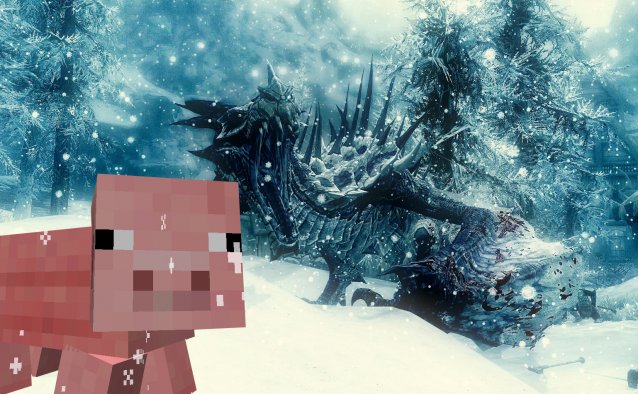
In the days following the release of Bethesda's Elder Scrolls V: Skyrim, my Twitter feed was ablaze with players announcing to one another their discoveries in this latest revealed province of Tamriel. "Did you find the movie theater yet?" "Hahaha, 'Notched Pickaxe.'" "Star Wars Easter egg in Bleakcoast Cave!" These tweets had the particular quality of fleshing out for the reader an expansive mental space--in my case of a game world I had no familiarity with at the time, since I hadn't myself picked up Skyrim at that point, and wouldn't until weeks later. After which, I became obsessed with trawling through Twitter's poor archival system to source these discoveries--and also found that despite being a latecomer, I was making new finds as well. At that moment, Skyrim didn't become a map or a space--it became actually inhabited. The territory.
The web is great for this sort of thing, whether it's facilitated through something like a collaborative wiki or social media. And really, if wikis and social networking resources have any higher calling to speak of, it's surely in the creation of collective knowledge wellsprings. The strength of Twitter as a factor in last year's Occupy movement, for instance, cannot be overstated. If we look back at the sudden burst of maturation these services have experienced over the course of 2010-2011, from the Arab Spring and the union protests in Wisconsin to the more recent Occupy confrontations at UC Davis and Berkeley, one might wonder how it was we habitually used these things to track celebrities and report the everydayness of our days before this.
Granted, of course, these practices still exist. In abundance, really But no one can now say that Twitter or Facebook are fundamentally tools for the idle and inane, not with so much evidence to the contrary. (Realistically, we should have stopped saying that during the 2009 Iranian election protests and subsequent violent suppression by the state, but Amerocentric media theorists tend not to pay attention unless something is happening in America.)
The key point here is that to use Twitter to inform the reader's understanding of something as complex yet artificially authored as a virtual territory--like Skyrim--just as much as to warn fellow protesters of police kettling in real world urban spaces, is to substantially reconfigure something structurally flat like a short form, text medium into something spatially dynamic.
And while we should definitely maintain an interest in the potentials for activism via social media, it's the former, turning these virtual spaces into relational topographies, that really intrigues me. It seems like an especially unusual take on the form, even as it hearkens back to analog roleplaying. Make fun of LARPing all you want, but those folks in Darkon have transformed plain ol' Baltimore into their own version of Middle Earth through groupsourced imagination alone. It's the same thing that (tentatively) goes on with Alternate Reality Games and Augmented Reality functions, but dressed down to its essentials: they've reskinned The Real World, and without fancy mod tools.
But that's not the only way web media lets us reconfigure virtual (and real) worlds. There's narrativizing the space, like we see in "Towards Dawn," Brendan Keogh's recently concluded screencap diary chronicling his travels through Minecraft. As the journal's subtitle ("Leaving the Miner's Life Behind") alludes, the blog subverts the primary activities of the game--to mine, collect, and build--and instead takes in the procedurally generated world of Minecraft as a territory. There is also the metatext, as Keogh's chronicle also creates a visual record of the game as it goes through server updates. One of his recent entries documents the Minecraft 1.0 update and its inclusion of NPC villages, which Keogh narrativizes as his avatar-adventurer delightedly discovering civilization:
I would stay in the village for the night. And, for the first time in forty-nine days, I would be safe in the knowledge that I was safe. I went back to the first house, with the person in white. They seemed to have no qualms with me staying, and I watched the sun set from the safety of their home.Several times over the past few days I have been tempted to stop this journey in one way or another, but never did I expect this. Never did I expect to find others. Now I have, and now I want to stay here, in the safety of the village, away from the vast and lonely expanses.
Minecraft may be a particularly well-known example of players turning the game on its head--it seems designed for it, as modular as it is--but we're seeing this happening in non-emergent multiplayer games as, such as the ARMA II mod Day Z. The success of Day Z even appears to have entirely outstripped the original game for which the mod was made. While it may still be in alpha, its players are already up to their elbows in expanded literature, producing everything from one-off tributes to their own serialized travelogues, all to capture the power of the mod's brutal gameplay. So we end up with websites like Day Z Diary, where J. Wilbur transforms the set of maps and systems into its narrative extreme, as a first-person survival story.
But you might say that all these examples--Skyrim, Minecraft, Day Z, even the Darkon Wargaming Club--all lend themselves already to an understanding of space as a location for story. That's not necessarily the case of all games' territories, though.
In an article for this very website, Keogh describes Audiosurf as "music for deaf people," Keogh rightly highlights how the game has the player "feel" music:
It doesn’t just render the songs visible. It render them tangible. The ups are ups. The downs are down. The louds are loud and the gentles are gentle. You don’t just see your music in Audiosurf; you feel through a sensation less like listening and more like dancing.
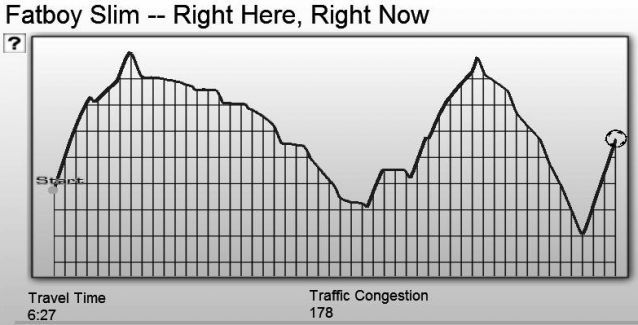
Audiosurf creates a topography from the user's music to procedurally generate a race track in which pitch, tempo, rhythm and syncopation are all incorporated visually. In addition to creating the road of various elevation, other signifiers like the pulsating radiant lines (indicating the distant finish line, but also the beats of the music), confetti, arches and color shifts all have a specific use toward enhancing this visualization.
As Keogh notes, Audiosurf is far from the only game to reconfigure the mp3 in some way, but it does perhaps do it more effectively than most of its competitors. It takes as its starting point the digital paradigm: music is not an event, but an artifact, one which can be reproduced and reinterpreted through different filters as easily as any other file. This recalls in some respects Hiroki Azuma's chapter on hyperflatness in Otaku: Japan's Database Animals:

In the computer world, although such a hierarchical relationship might be correct as an explanatory principle, it has little physical ground. For if such a thing as the "true form" of a computer file exists, it is a mere electromagnetic pattern stored somewhere in hardware, and the hexadecimal notation, the text file, and the image are no different insofar as they are all an interpretation of it.[...] This structure wonderfully reflects the postmodern world image. In postmodernity, the deep inner layer of the world is represented as the database, and the signs on the surface outer layer are all grasped as an interpretation (combination) of it.
All electronic gaming is built upon a visual reinterpretation of data, stored in a nebulous somewhere (Azuma is here writing before the popular ascent of distributed servers and cloud computing), and accessed locally by the user. The changes the user makes are updated in real time by the same vague process, the brunt of the actual computing kept invisible from her field of play. We are only made aware of these virtual spaces when something begins to threaten their stability: the player becomes stuck opening the same door again and again as her Minecraft server lags; virtual items vanish from virtual inventories and result in real-world lawsuits. The immateriality of all this "virtual stuff" only brings itself to bear on our awareness when its integrity is in some way called into question.
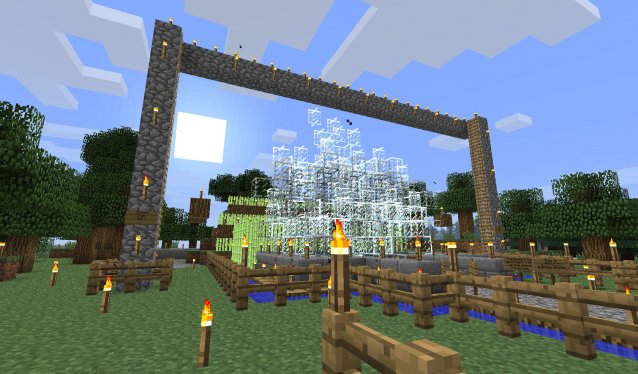
I played consciously with this in an art installation located in USC Interactive Media Division's private Minecraft serve. I've blogged a bit about this previously, but I wanted to take this opportunity to go into further detail about its aesthetic inspirations and the final work.
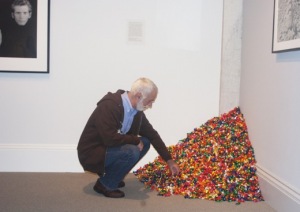
Photo credit: Molly Roberts, Smithsonian Mag
As I mentioned before, my glass installation --which requires the visitor to participate by destroying part of the structure-- is strongly influenced by the process art of Felix Gonzalez-Torres, whose minimalist installations were able to create a striking statement through everyday objects like paper and candy. For him, the mundane nature of these objects were the point: simple, common, tangible, yet abstract, and devastating. One of his most powerful works to me is "Untitled" (Portrait of Ross in L.A.), in which he represents the declining health of his lover with a pile of wrapped candy that is steadily depleted by the art patrons. There is so much that can be read into even the act of participation: is it complicity or awareness? Is it sympathy or murder?
I have no doubt that games can be models for these kinds of questions, but that doesn't by default make Minecraft art, so much as a system which under the right circumstances can facilitate art's emergence. It's a toolset through which I'm able to reproduce a rough facsimile of the most superficial attributes of a Felix Gonzalez-Torres artwork-- but it still has none of the meaning which imbues "Untitled" (Portrait of Ross). I don't have a dying lover, nor is my structure arrived at through any other great emotional struggle. It is (pretentiously, as a just-barely-graduated masters student) a representation of the ephemeral nature of all this virtual stuff, and if there is any pain to speak of here, it is that we labor so long and so hard on things which will blip out with a single server crash (or creeper detonation).
As it turns out, that is exactly what happened to the USC server hosting this work not long after the class in which I built it concluded. Even if the server is brought back online, the work will in all likelihood be gone. So the only thing that now exists of that particular world of Minecraft only exists in memory and my rather brief documentation. Even the map I once tried to fill out is now hopelessly irrelevant, referring to a topography that no longer exists and can never exist again.
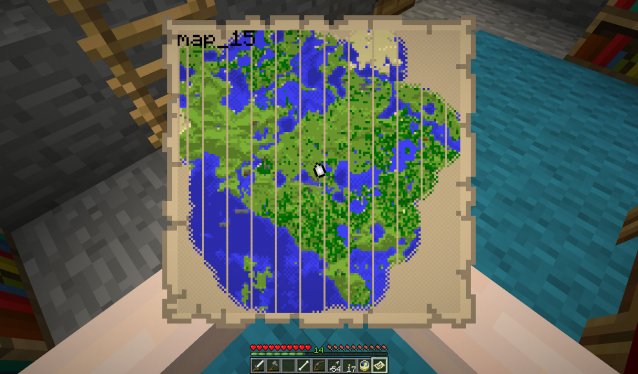
This conflict of what Minecraft can be versus what it is lies somewhere near the heart of the problem with this article written last year by Kirk Hamilton, "Skyrim Will Have Infinite Randomly Generated Content. But Will It Ever Feel as Real as Minecraft?" The problem, of course, is there is a significant difference between procedural quest generation and procedural map generation, the latter being what Minecraft uses to feel "real."
I'm not certain that "real" is even the appropriate word for a game like Minecraft. Certainly the game is able to leave a distinct impression, inspire a sense of longing, maybe even a sense of nostalgia for some pastoral, frontiersman fantasy of self-made wealth and security. But it's also completely ephemeral. It dies when the cord is pulled or the server is wiped. Skyrim, at least, is the same Skyrim for everyone. And it will continue to grow the more players explore it and report back their findings, even if the boundaries stay finite.
(Which they won't, thanks to the Creation Kit. As if you needed another author to tell you PC is better.)
All of this is to say that all these games I discuss here--Skyrim, Audiosurf, Day Z, Darkon and Minecraft--are all concerned in their own ways with spatiality, and to varying extents the communities of knowledge which grow up around them. Keogh, in his own words, is "an Audiosurf evangelist" and most likely knows more about the algorithmic principles underlying the game than I can ever guess at, but otherwise the game does not have even a shade of the knowledge culture engendered by the other three. And yet, even in the absence of collective servers and universal landmarks, there is a sort of Audiosurf map which gets worked out-- like the shared playlist project Keogh and a few of our mutual colleagues are putting together over Twitter. They're all, in my estimation, excellent ventures into the collective creation of spaces, using mainly mental visualization to construct from limited personal impressions a wide, wide network of experiences.
In a sense, I traveled Skyrim before I ever owned the game, and know what it takes to survive Day Z without downloading the mod. I can't intimately know these spaces without interacting with them, in much the same way that declaring Audiosurf "music for deaf people" is also a terrifically problematic assertion. But they lay a sort of groundwork, if you will-- the knowledge communities I interact with enrich the mental map I finally create. That is the "territory": not just a map, not just a space, but the understanding and meaning we fill it with.
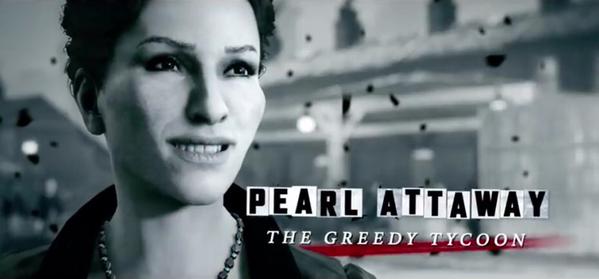

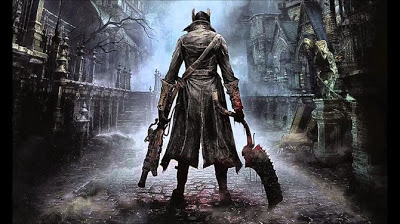
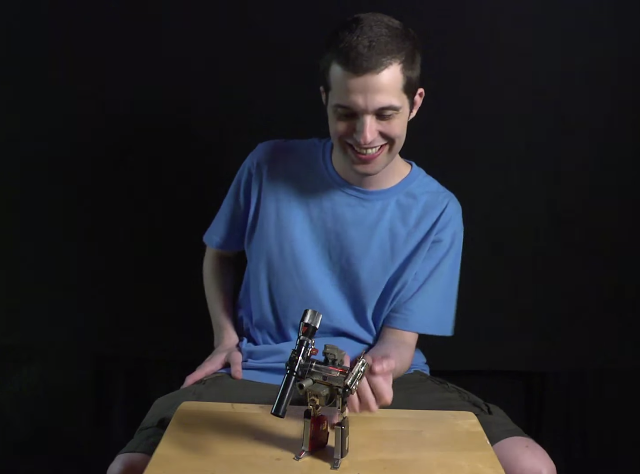
 10 League of Legends Champions to Get You Out of Bronze
10 League of Legends Champions to Get You Out of Bronze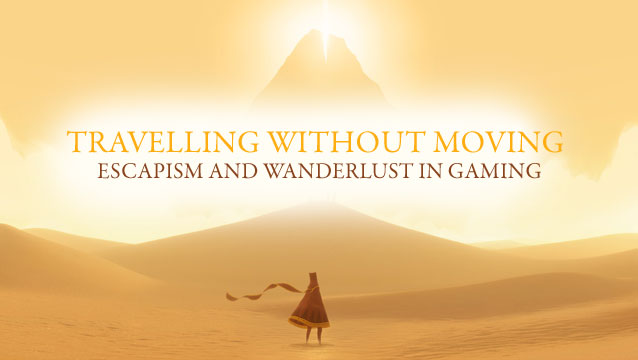 Travelling Without Moving: Escapism and Wanderlust in Gaming
Travelling Without Moving: Escapism and Wanderlust in Gaming Call of Duty: Advanced Warfare Wiki – Everything you need to know about the game .
Call of Duty: Advanced Warfare Wiki – Everything you need to know about the game . How To Find All New Gwent Cards In The Witcher 3: Hearts of Stone
How To Find All New Gwent Cards In The Witcher 3: Hearts of Stone Should You Get a PS Vita with a PS4?
Should You Get a PS Vita with a PS4?